#and it’s not like it was even. significant to the narrative in any meaningful way.
Explore tagged Tumblr posts
Text
Umineko Episode 3 Blog: Once Upon A Time
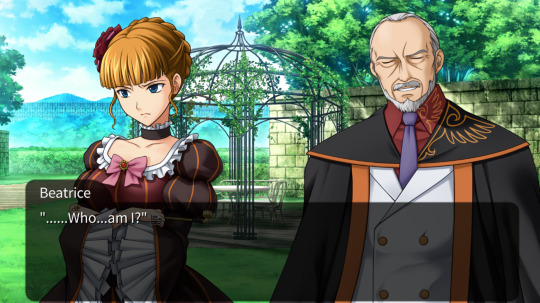
I had a feeling a topic like this would eventually come up. There are only so many "unforgivable" things a man in Kinzo's position could have done to his unrequited love. Somehow, it seems the truth was far worse than I thought.
I had found Episode 2 to be a largely uneventful affair. I liked the focus on Shannon and Kanon's characters at the start, and their relationship to "Beatrice," and Rosa was a riot as usual, but beyond that a huge chunk of it felt like I wasn't really getting much new information. Episode 3 kind of feels like Episode 2, but better. The magic part of the story is more interesting and has more meaningful implications on the mystery side of the story instead of being random nonsense, the game throws interesting twists on the mysteries of the previous games (killing off all of the servants on 1st Twilight was such a cool idea), and Ryukishi has provided so much important context regarding the killer's motivations, where before all we knew was that it was Sayo and her reasons had something to do with her solving the epitaph.
I'm told that people at the time found Episode 2 too difficult, and Episode 3 was in some ways a response to that, which is why we get treated to Virgilia explaining what an unreliable narrator is to Battler for the sake of those poor souls who hadn't caught on up to this point. It seems like Umineko has finally finished establishing its basic narrative tricks, and now we get to just have fun with it, although "fun" is maybe the wrong word for the main topic of this post.
Beatrice gets a bit shifty about explaining her backstory, as we'd expect from her. She wants us to believe that her death, as witnessed by Rosa, makes it impossible for the secret mansion to have any connection to the Rokkenjima murders, but it's clear that the Beatrice in the prologue is not the one from Rosa's story. Unfortunately, we've gone full Yu-Gi-Oh at this point and we have way too many different Beatrices running around, so for the sake of my sanity:
Beatrice I: Kinzo's mistress from long ago. May or may not have provided gold. Commit suicide after her daughter was born.
Beatrice II: Daughter of Beatrice I and Kinzo. Met Rosa. Died after falling off of a cliff.
Beatrice III: girl who broke a vase in the prologue. Describes Kinzo as her grandfather, which, troublingly, means she's probably Beatrice II's daughter.
Beatrice: Battler's nemesis in the meta-plot. On a metaphorical level, she's sort of a vague amalgamation of everything and everyone who's received the name of the golden witch.
Virgilia: Beatrice III's caretaker, who appears in the meta-plot and magic narrative as a mentor witch. In reality, Virgilia is Kumasawa. It's a well-executed Chekov's Gun: we were told in Episode 1 that Kumasawa often quits and then comes back after a while. The implication seems to be that whenever Kumasawa "quits" working for the Ushiromiya family, she's actually just being reassigned to the secret mansion to look after whichever Beatrice is staying there.
Sayo: masterminded the Rokkenjima killings, while occupying the role of the golden witch.
Eva: Kinzo's eldest legitimate daughter. Took over a significant chunk of the killings in Episode 3, after solving the epitaph. Was it simple greed, or are we again finding out that the epitaph hides an additional secret that makes those who solve it lean toward committing the killings?
EVA: Eva's inner child turned witch. Typically appears in the magic narrative to explain away the killings. Symbolically represents that Eva and Sayo do not have the same ends, even if they end up using the same means.
Ange: I guess they're just letting anyone be a witch these days.
Beatrice's explanation about being locked in the body of Beatrice II tells a horrid story between the lines: Kinzo had a daughter with his mistress, and after her death, he groomed his daughter to serve as her replacement. The fact that Kinzo has an extra grandchild we can't account for would seem to imply that he tried it twice. Beatrice tries to obscure this fact by working through Rosa, who didn't have enough context to understand the situation.
In any case, based on the timeline I'm guessing that Beatrice III is Sayo. She's the only realistic candidate I can think of who's involved in the story, and explains a lot. The servants are willing to work with Sayo out of a sense of obligation toward her, both because Kumasawa at the very least probably feels a lot of guilt at being complicit in the situation, and because Sayo probably became the de facto head after Kinzo died. I bet he'd sooner appoint her than anyone else in his family, although the rest of the family would certainly have disputed the claim if she'd come forward initially.
I do wonder what Kinzo was thinking having Sayo become a servant. Maybe a cover story, since the truth behind her birth was too shameful to admit? Another possibility is that the servants just got one over on ol' Kinzo and sent Sayo to the orphanage at some point, pretending she was someone else. I feel like Sayo had to end up at the orphanage somehow, even briefly as part of her cover story, since she needs to meet Kanon at some point.
The implications of this on Sayo and George's relationship aren't great, but we've already crossed that line by now, and Episode 2 did establish that Shannon avoids being physically intimate with George. Did Shannon enter this relationship in some attempt to get control over the family's assets, knowing that her claim would not be respected under normal circumstances, or did she only come to fully understand who she was and where she came from after solving the epitaph?
Sayo's connection to Beatrice feels very different now. Sayo probably doesn't even remember her mother, so the closest she's got is the legend of the witch. No wonder she takes on that role to get revenge on the family. The whole theme in the first letter of taking back what's rightfully hers fits much better as well.
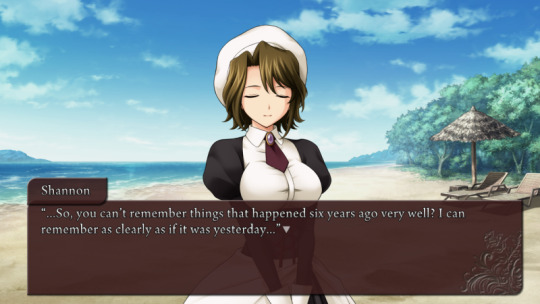
We still don't fully understand Sayo's motivations. The whole conversation on the beach about Battler's childhood crush really feels like it's foreshadowing a reveal later. I'm guessing it's something like: Battler threw out a cringy line about coming back for Sayo on a white horse because he was 12, and then ditched the family. Back in Episode 1, George asked Shannon why she had stayed employed as a maid for so long, after already saving a fair amount of money. The truth was that Sayo was envious of Battler leaving everything behind, and, like her mother blindly trusting Rosa, she secretly clung to the childish notion that one day he really would come back for her and take her away from Rokkenjima and the Ushiromiyas, but instead Battler came back and implicitly revealed what she probably should have known: he never took it seriously, and that was the straw that broke the camel's back.
That's enough of that depressing topic. Next time, we get treated to Peak Eva Content.
#umineko episode 3#liveblogging#umineko liveblog#umineko when they cry#umineko no naku koro ni#umineko
19 notes
·
View notes
Text
oh yeah, on a whim I pre-ordered a bl on bookwalker and suffered L after L for the hubris of picking up something I hadn’t already read. like first of all, the preview for the volume ended right before a surprise age gap reveal that was *not* indicated in the summary, second of all it was boring as hell. I’ll remember to eliminate what little trust remains in my heart for all future endeavors.
#orlbs#misclb#like in hindsight yeah alright. but it’s still not actually indicated before that :/#like I’m not going into the discourse side of things.#*I* don’t want to read that and I’d rather have a clear indication of what I’m getting into so I don’t get age gap jumpscared -_-#and it’s not like it was even. significant to the narrative in any meaningful way.#and this is after game-ya’s update#so going from a story with an age gap between adult characters that the author actually uses#to a story that’s so. shallow about it on top of [waves hand] The Other Stuff#the problem with ebooks is you can’t return them. or even dump them onto someone else.#I’d give this to someone for free I don’t want it in my library
9 notes
·
View notes
Text
Nearly every time I've rewatched Infinity Train Book 3 since I first saw it in February, I saw more parallels and narrative echos, and infodumping my friends about them isn't enough anymore
I figured I should do a post about this one because I don't think I've seen a post about that specific thing yet, and I love this show's writing, and. idk. I just need to praise it I guess
So, the most obvious part first:
Grace became everything she hated about her parents
When Grace mentions her mother in the Debutante Ball Car, it's made pretty clear she's trying to distance herself from her mother as much as possible, and at this point, we realise retrospectively that Grace's room in the Mall Car in episode one was full of sports clothes - it seems she tries to avoid things reminding her of her life before the train. And of her mother. And yet-
She tries to control everyone and everything around her, and makes people do what she doesn't want to do


And she decides what's cool and what isn't


She makes people kneel in her presence, like her mother towers over her in her mind's eye


Obviously she constantly lies to get what she wants, and her dad does that in her tape

When her younger self looks up, she looks right through adult Grace, and it's actually her parents she's looking at! Her younger self is metaphorically seeing her parents where her adult self is standing!! I still can't get over this shot

Also I feel the need to mention her mother has the same voice actor as her in her tape and even if it might be to cut corners in the budget, that feels significant (and to be fair, sometimes you can cut corners while making meaningful choices at the same time)
Now you might think I'd have nothing to say about Simon on that matter, since we don't see any flashback of his life before the Train, and we know next to nothing about his parents. But I think it's very telling that the only actual backstory we get for him is his backstory with The Cat.
Because-
Simon became everything he hated about The Cat
Ok I never see anyone mentioning this, but hear me out
First, we have no idea if Simon knew The Cat was routinely invading people's privacy through their memory tapes, but he sure has no issue doing the exact same thing


But that doesn't stop there. He also collects things obsessively


And makes kids collect things for him as well, by the way


He thinks he's above others, but he immediately switches to victim mode when it comes back to bite him


HE. ABANDONS. A CHILD. WHO WAS UNDER HIS CARE!!


And. Uh. They both dig their heels instead of trying to change, too



Don't get me wrong, on some level I would have liked to know what Simon's parents were like too. I would have liked that a lot. But there's a good chance it wouldn't change anything, because everything we need to know about his background to understand why he's Like That™ is already in the show
But yeah, Grace and Simon both pretend they found freedom on the Train, and both distance themselves from parental figures who are at the source of their trauma, claiming they're different and better than them - and yet they are both subconsciously repeating patterns that caused at least part of their problems and/or trauma in the first place
And since they decided that making numbers go up was good, as long as they stick to that idea, they are bound to never escape from that self-perpetuating loop of harm and trauma
And I love it
And I hate it
#infinity train#grace monroe#simon laurent#samantha infinity train#this has been in my drafts since May
429 notes
·
View notes
Text
As much as the term is misused by reactionaries to mean 'cultural degeneracy', there is in fact such a thing as postmodernism, and it is in fact, like the other ideological currents that become prominent under capitalism, bourgeois in character.
Modernism was the ideological undercurrent of the historical materialist works of Marx, the nationalism of fascists, and the utopianism of the liberals. It was the shared belief held in the early capitalist period that the universe, the world, and human society were all fundamentally knowable and understandable to mortal men. The advance of the sciences and liberal enlightenment philosophy were, genuinely, an incredible and liberatory force in the revolution against the feudal world-system. Only in the capitalist period, with the development of the means and relations of production, could such an understanding of society as Marxism exist - Marxism being, fundamentally, the application of the scientific method to human history in service of the proletariat.
Post-modernism, as an ideological current, was developed in the NATO block following the second world war, though it had been incubating prior, at a much increased rate since the establishment of the first socialist state. It represented a rejection of modernism's 'grand narratives', and an assertion that each and every individual experience was so utterly unique and varied that it was impossible to draw any meaningful conclusions about society at large - only about specific people. Post-modernism is not only the basis of the genocidal neoliberal ideology whose economic shock doctrine wracked the global south, but also of a significant portion of 'progressive' ideologies (the similarity, ultimately, of the Margaret Thatcher quote to the belief of the average 'communists are homophobic!' claimant not escaping notice). Fundamentally, it begins its analyses not from the scale of society to progress towards the individual, but from the individual to extrapolate out to society - it is an idealism that reduces all things in society to individual psychological quirks (or disorders, egads).
In the context of a post-modernist system (even world-system), the correct theory (in order to carry out correct practice) will necessarily need to deviate from traditional, modernist thought in some ways. In which ways it must deviate can only be discovered through practice, but we know that it cannot simply absorb elements of postmodernism in an eclectic manner - it must be a genuine synthesis, whose principal purpose is to overcome, annihilate, and replace postmodernist thought (along with the rest of bourgeois thought in general).
533 notes
·
View notes
Text
On TAZ-
Wow that sounds like I’m about to summarize some sort of discourse but I promise I’m not. I guess I’ll say that I really like this show and I will keep listening even if my worst fears come to pass, so keep that in mind!
For reference, I started listening near the end of Amnesty.
I’ve noticed, with the past few arcs- really since Ethersea- the narratives have just… not been fulfilling their promises, so to speak. They’ve been placing a lot of guns that don’t go off. What I mean by that is, the characters are great. Excellent, really. Lady Godwin? HELL YES. Emerich Dreadway? Fuck yeah! And so on! And the settings and premises have been epic- the goofiness and also horrifying nature of Engrave, the mad and thrilling world of Steeplechase- these things are COOL AS FUCK.
and then the actual narratives keep flopping?
And honestly, I notice it most in the endings, because you can really tell when an ending doesn’t land. You feel the sense of disappointment. But with vs. Dracula, for example, I could kinda see leading up to it that the ending couldn’t really BE anything special, because they lowkey didn’t set themselves up for it.
They spent the campaign fucking around in Engrave, finding clues and solving problems and not really experiencing any particularly meaningful character arcs or growth or, idk, forming relationships? So there wasn’t much to pay off, I’m not gonna lie!
Of course it doesn’t feel quite as dissatisfying when you’re in the thick of it, because they’re funny and the stuff is cool and- oh hey! Lady Godwin’s been turned into a werehorse against her will?? that’s got some real potential for a LOT of allegories and exploration of some fun character development! And then it’s kinda played as a joke. And then they do that again and again.
And they actually said that that was a move they made intentionally, in the TTAZZ. I’m not quoting them perfectly here, this is from memory, but I do remember them mentioning that they wanted lighthearted comedy without the burden of real life story stuff. And I get that, honestly, but… it’s not the choice I would’ve made. I do think you can keep a lighthearted tone while also, idk, forming relationships and wholesomely engaging with some amount of emotion. And sometimes going way too deep is funny as a tone shift!
But I digress. One thing that’s also popped out to me is the almost complete lack of any kind of romantic storyline or even references. This becomes obvious if you’re in a fandom because everyone is always dying to ship SOMEONE, and you can tell when people are really getting desperate. I don’t blame them for not wanting to roleplay romance with their family, and I do think stories lacking romance are COOL and SHOULD BE ENCOURAGED!
However if you can’t find ANYBODY to ship together… that may mean you just don’t have character bonds. The growing popularity of the PC polycule is interesting to me; I wonder if it’s partially because
a) none of the pcs have significant relationships outside of their party and
b) even within the party, there doesn’t seem to be much chemistry between any given pair of characters…? I hope I’m making my point well here- the PCs all seem equally close and have more or less the same relationship to all of their compatriots with little distinction, meaning, essentially, no shipping fodder that doesn’t involve just all of ‘em.
Either way, it makes me wonder if I can blame the “Graduation has too many NPCs!” critique. They really stopped giving the parties tag-along main NPCs after graduation, with the exception of maybe.. Urchin? Kodira? Shlabethany? Poppy? and even they get relatively little “screen” time. Steeplechase has great NPCs, I love them to death, but none of the PCs seem to ever have one on one conversations with NPCs or each other that do not explicitly focus on the plot. And I think that’s part of why the characters feel so underdeveloped despite having spent a lot of time with them- because in this character-driven genre, we get very little insight into their feelings or motivations or even their rudimentary backstories.
I started watching Fantasy High recently and it made me realize a couple things about TAZ.
1) Recently, TAZ has sooo few core NPCs, and it’s weird that the characters aren’t doing more one-on-one purely character based scenes. And that makes it really tough to develop them.
2) TAZ is- and I should have realized this before- one of many good dnd podcasts. They’re probably looking for a niche they can master.
And it sounds like they’re trying to get back to that old “Here there be Gerblins!” energy. They’ve referenced it so many times in recent TTAZZes- they wanted to be job-focused, allowing story stuff to happen organically, so they tried a more open world vibe with Ethersea. They wanted to be less afraid to kill stuff, so they tried playing criminals (and were still afraid to kill stuff). They wanted to be silly and light on character, as they tackled with taz vs dracula. Now they’re trying to bring in the silly cartoon vibe with Abnimals. I think they’re trying to make that family-friendly, funny and goofy show their niche. Something other actual plays can’t be better at them at.
And honestly it kinda makes me sad, that they keep trying to go back to Balance while ignoring everything they learned during it. Because I loved Dust. Because I loved Amnesty. Because I loved Ethersea. I loved these past arcs! But they keep doing their brilliant characters dirty for some reason!!! And i don’t know why!!!!
You know that meme about people who ask questions in movies and then the person responds “Have you ever been to a movie before? You watch them and the information is revealed.” There have been so many times in TAZ recently where information has Not been revealed and if they keep doing it the audience will stop bothering to suspend their disbelief, because the trust just isn’t there.
What is Montrose’s deal? What on earth was Carmine Denton’s whole thing? Tell me more about Zoox’s feelings, about Devo’s past, about Amber’s future. Show me how Lady Godwin feels about the body horror that is her life- like, seriously! WHY DID WE HAVE TO COMPLETELY DISMISS THE OPPORTUNITY TO DISCUSS GENERATIONAL TRAUMA IN MUTT’S LIFE FOR A JOKE??
Do you remember in Steeplechase where the boys were getting medical attention or something- i don’t remember, but they were all in one room and only talking about The Plot. And Poppy literally banged on the door (speaking for both Justin and me, tbh) and was like “does anyone want to share any feeeeelings??” and they were like NOPE! and they moved on!!
like. cmon. you can’t just put a character like montrose out there and then leave them severely underdeveloped to the point that what would be interesting in proper context, with audience insight, becomes confusing and chaotic.
I just wish they would take their stories as seriously as we do.
It feels to me like they don’t believe in themselves, and it makes me sad. Maybe they didn’t get the response they wanted from Ethersea and so they’ve been trying to pivot, hoping to recapture whatever it was that earned them a loyal audience.
Again, I love them. They’re so funny and I’ll keep listening until the day they stop making this show, and when it happens I’ll cry.
But i KNOW they have more in them. Remember the “we’ll grow gills” monologue from Justin in the Prologues? Remember Travis’s SOLID acting with Devo? Or his awesome choice to give Lyndon/Beef a clearly delineated work/irl identity? His excellent narration and prose? Remember when Montrose described being lonely?! Remember all those moments where Shit Got Real and you cared??? The nanofather said some dope shit! dracula and victor and sweater dracula had such a wild dynamic! Clint’s acting in Dust 2- I can’t remember the characters name right now- was ASTOUNDING, I genuinely didn’t know he had that in him and it blew me away!
I’m not referencing Balance on purpose, both because the fandom is way to hung up on it and because I want to prove that you don’t even have to look at Balance, or even Post-Balance arcs, to see this kind of good cool stuff!
GAAAAAAAGHHHH!!! I want them to have fun. But also. We’re starving out here.
#that’s all for now#i need to go to bed..#taz#the adventure zone#taz steeplechase#taz vs dracula#taz ethersea#cheshi squeaks
207 notes
·
View notes
Text
When attempting to critique the values of a long-running franchise like STAR TREK, it's important to draw a distinction between superficial issues and structural ones.
"Superficial" in this sense doesn't mean "minor" or "unimportant"; it simply means that an issue is not so intrinsic to the premise that the franchise would collapse (or would be radically different) were it changed or removed. For example, misogyny has been a pervasive problem across many generations of STAR TREK media, which have often been characterized by a particular type of leering-creep sexism that was distasteful at the time and has not improved with age. However, sexism and misogyny are not structural elements of the TREK premise; one can do a STAR TREK story where the female characters have agency and even pants without it becoming something fundamentally different from other TREK iterations (even TOS, although there are certainly specific TOS episodes that would collapse if you excised the sexism).
By contrast, the colonialism and imperialism are structural elements — STAR TREK is explicitly about colonizing "the final frontier" and about defending the borders, however defined, of an interstellar colonial power. Different iterations of STAR TREK may approach that premise in slightly different ways, emphasizing or deemphasizing certain specific aspects of it, but that is literally and specifically what the franchise is about. Moreover, because STAR TREK has always been heavily focused on Starfleet and has tended to shy away from depicting life outside of that regimented environment, there are definite limits to how far the series is able to depart from the basic narrative structure of TOS and TNG (a captain and crew on a Starfleet ship) without collapsing in on itself, as PICARD ended up demonstrating rather painfully.
This means that some of the things baked into the formula of STAR TREK are obviously in conflict with the franchise's self-image of progressive utopianism, but cannot really be removed or significantly altered, even if the writers were inclined to try (which they generally are not).
What I find intensely frustrating about most modern STAR TREK media, including TNG and its various successors, is not that it can't magically break its own formula, but that writer and fan attachment to the idea of TREK as the epitome of progressive science fiction has become a more and more intractable barrier to any kind of meaningful self-critique. It's a problem that's become increasingly acute with the recent batch of live-action shows, which routinely depict the Federation or Starfleet doing awful things (like the recent SNW storyline about Una being prosecuted for being a genetically engineered person in violation of Federation law) and then insist, often in the same breath, that it's a progressive utopia, best of all possible worlds.
This is one area where TOS (and to some extent the TOS cast movies) has a significant advantage over its successors. TOS professes to be a better world than ours, but it doesn't claim to be a perfect world (and indeed is very suspicious of any kind of purported utopia). The value TOS most consistently emphasizes is striving: working to be better, and making constructive choices. Although this can sometimes get very sticky and uncomfortable in its own right (for instance, Kirk often rails against what he sees as "stagnant" cultures), it doesn't presuppose the moral infallibility of the Federation, of Starfleet, or of the characters themselves. There's room for them to be wrong, so long as they're still willing to learn and grow.
The newer shows are less and less willing to allow for that, and, even more troublingly, sometimes take pains to undermine their predecessors' attempts along those lines. One appalling recent example is SNW's treatment of the Gorn, which presents the Gorn as intrinsically evil (and quite horrifying) in a way they're not in "Arena," the TOS episode where they were first introduced. The whole point of "Arena" is that while Kirk responds to the Gorn with outrage and anger, he eventually concedes that he may be wrong: There's a good chance that the Gorn are really the injured party, responding to what they reasonably see as an alien invasion, and while that may be an arguable point, sorting it out further should be the purview of diplomats rather than warships. By contrast, SNW presents the Gorn as so irredeemably awful as to make Kirk's (chronologically later) epiphany at best misguided: The SNW Gorn are brutal conquerors who lay eggs in their captives (a gruesome rape metaphor, and in presentation obviously inspired by ALIENS) when they aren't killing each other for sport, and even Gorn newborns are monsters to be feared. Not a lot of nuance there, and no space at all for the kind of detente found in TOS episodes like "The Devil in the Dark."
#teevee#star trek#star trek tos#star trek the next generation#star trek picard#strange new worlds#i find strange new worlds largely unwatchable#and this is a major reason why#along with their determination to no-homo spock
468 notes
·
View notes
Text
In Stars And Time (and its predecessor Start Again to a degree) did something really impressive in a video game: making a non-combatant child character not only likeable, but critical to the fabric of the story. Notably, the Kid is not a primary story character. They represent the common folk of the endangered fantasy land; someone whose home and family was taken by the Big Bad, leaving them stranded.
In the core party, we have the Housemaiden, blessed, immune to the worst status effect, bearing a unique elemental type, etc. It's actually very amusing that she is blatantly The Main Character of this story, because she isn't the POV character.
With her we have the Fighter, a good-hearted tank who worked as a Defender in the homeland of the first three; the Researcher, a foreigner traveling the land, who's book-smart and has a wide array of spells, the wizard type.
And then we have the POV character, Siffrin, a classic Improbably Good-Natured Wandering Rogue archetype. You know, the classic shifty thief-type and troublemaker who nonetheless aids the party without thought of reward and isn't actually a criminal despite the vibes? That kind of rogue.
The Kid isn't a playable character. They can contribute to combat, but it's randomized. The most you can do is equip them with gear and skills that affect the frequency of their input, and ask them to feed the party heals (and possibly feed the final boss a bomb).
What the Kid is, what they represent, is in many ways the emotional core of the party (as the party knows it; Siffrin might develop different ideas, but, notably, still cares deeply for the Kid's wellbeing).
The Kid provides snacks, which is partly about their heals-carrying role, but it has a broader application. Between each level in the main dungeon, there's a snack break with three options. As you play the game, looping over and over, choosing different snacks can be the most you can break out at times. Snacktime also creates a narrative and gameplay break, a time to chat with the party one-on-one.
The Kid is the moral support and backbone of the party; it's possible to tell this story without them, but it would, frankly speaking, be a less emotional, less interesting story, with lower stakes. The Kid is at risk when you fight; the adults team up and agree to protect them no matter the cost, and this is not a throwaway line. This has consequences. This creates texture.
Late in the game, Siffrin develops the option to do Party Member Personal Quests, and despite being a noncombatant, the Kid is one of them. All of these Quests are meaningful and important in their way, but the things we learn in the Kid's Quest are extremely important to understanding Siffrin. The other Quests have personal elements that Siffrin relates to, but this one is about him in a very specific way, that could not be fully replicated by mirroring the events referenced onto one of the adults. This Quest pans out the way it does because the Kid is a kid.
It's hard for me to put into exact words, especially when I don't want to spoil things, but there's even more specific details that make them important to the narrative progression, again, without being an "important" person in the context of the game world. By being important to Siffrin and the rest of the party, by having their narrative wound in with the others, the Kid is as integral to the story as any other character.
Kid characters like this in video games aren't often well-respected, and that tends to be for good reason - they tend to represent ludonarrative dissonance, be annoying, or be the product of overcompensation and have their importance rubbed into the player's face. Many of them could be extracted from the narrative without having a significant effect on the outcome, or would destroy the narrative because they're the focus character, borderline Morality Pets for protagonists. The Kid in ISAT and SA fascinates me, because I came to care about them in a very natural manner, not just because their personality and interactions are endearing, but because the way they and the other party members relate to each other has a tangible impact on the story and emotional core of the game.
#elk text#elk plays in stars and time#in stars and time#minor spoilers?#the kid#go play ISAT#or go play SA and then ISAT really#the backbon of the party
263 notes
·
View notes
Text
DAY 5973
Jalsa, Mumbai June 25/26, 2024 Tue/Wed 2:07 AM
Birthday - EF - Anamika Gupta .. 🙏🌹
Ef Özen Eren Wednesday, 26 June .. and all ur prayers and wishes for this special day for the Ef ..
the Agenda .. an act of predetermined thought and conveyance .. what shall bring attention recognition be the intent .. any express that can remotely be given the spin, and mastered is the guile and expertise of such ..
it is lamentable , ignominious to witness the impotency of content .. to somehow in any which manner , to be able to draw attention in storied form, just so it can be put up and seen or read , in favourable condition to them that devise it ..
devise .. for the right is not needed to be devised ..
pity ..
never ever underestimate the generation that follows , or is about to follow .. they are aware and alive to every situation and knowledged to hold their own in debate or discussion ..
we are enriched by the circumstance that often fall upon us .. and then we find a way .. even when there be none ..
"In today's digital age, the ubiquitous nature of content has paradoxically led to a dilution of its potency. With the democratization of content creation, anyone with an internet connection can produce and distribute information, leading to an oversaturation of the digital landscape. This phenomenon has profound implications, rendering content less impactful and more ephemeral.
First, the sheer volume of content available online has created a paradox of choice. Every minute, hundreds of hours of video are uploaded to platforms like YouTube, thousands of blog posts are published, and millions of social media updates are posted. This relentless flow of information makes it difficult for any single piece of content to stand out. The audience, overwhelmed by options, often resorts to skimming or entirely ignoring vast amounts of content, diminishing its overall impact.
Moreover, the quality of content has become highly variable. While the ease of content creation has empowered many voices, it has also led to an influx of low-quality, poorly researched, and sometimes misleading or false information. This glut of mediocre content competes with high-quality, well-researched pieces, making it challenging for audiences to discern value and trustworthiness. As a result, even content of genuine worth can struggle to achieve the recognition and engagement it deserves.
Another critical factor contributing to the impotency of content is the algorithm-driven nature of content distribution. Social media platforms and search engines prioritize content based on engagement metrics such as likes, shares, and comments rather than the inherent quality or informational value. This prioritization often leads to the virality of sensational, clickbait content at the expense of substantive, insightful work. Consequently, the attention economy favors superficial engagement over deep, meaningful interactions with content.
Additionally, the fast-paced consumption habits of modern audiences further erode the potency of content. The average attention span has dwindled in the face of constant digital distractions. People increasingly consume content in bite-sized formats, such as tweets or short videos, which limits their exposure to in-depth analysis or comprehensive narratives. This shift towards brevity undermines the ability of content to foster nuanced understanding or sustained engagement.
The commercialization of content also plays a significant role in its diminishing impact. Content marketing has become a dominant strategy for businesses, leading to a proliferation of branded content. While this can provide value, it also contributes to the noise and can sometimes prioritize promotional messages over genuine, informative content. The blending of editorial and advertising content can lead to skepticism and diminished trust among audiences, further reducing the impact of the content they encounter.
Lastly, the fleeting nature of digital content means that it often has a very short lifespan. Unlike traditional media, which could have a lasting presence, digital content is quickly buried under the avalanche of new information. This ephemeral existence means that even impactful content can be forgotten rapidly as attention shifts to the next trending topic.
In conclusion, the impotency of content in today's times is a multifaceted issue stemming from the overwhelming volume of information, variable quality, algorithm-driven distribution, changing consumption habits, commercialization, and the ephemeral nature of digital content. To reclaim the potency of content, creators and platforms must prioritize quality, foster trust, and find ways to engage audiences meaningfully and sustainably amidst the cacophony of the digital age."
Love and more ..

Amitabh Bachchan
115 notes
·
View notes
Note
I feel like Homestuck is an interesting case study when it comes to comparing numbers of M/M vs. F/F fanworks. Because the gender ratios of Homestuck's protagonists are scrupulously balanced -- all of the protagonist groups have exactly equal numbers of male and female characters.
However, just because the genders are balanced in theory, that doesn't necessarily correspond to the characters' prominence in the narrative. Dave and Karkat (both boys) have the most lines of any characters in the comic… and guess what, Davekat is the most popular ship! Meanwhile, the two original female leads (Rose and Jade) barely have any conversations with each other over the entire comic, and both of them have significantly fewer lines than the two original male leads (Dave and John, who do interact with each other a lot and are the third most popular ship on AO3).
There are places where (Tumblr and AO3) fandom's preference for male characters becomes obvious, though. The trolls (a secondary protagonist group) are technically gender-balanced, but the ones who end up becoming most important to the narrative are mostly girls. And yet Eridan/Sollux (a ship featuring two minor male trolls) is almost twice as popular on AO3 as Vriska/Terezi, two girls who are both very important characters and whose deliciously complicated relationship is frankly the core of Homestuck. And to be honest, I do truly believe that Vrisrezi would be way, WAY more popular if Vriska and Terezi were boys instead of girls.
But really… even if it's not "fair" that Erisol is more popular than Vrisrezi, there's no point in scolding people for their individual ship preferences. People like what they like, and if someone isn't interested in femslash, guilting them over it isn't gonna magically make them enjoy it.
Hell, I'm part of the "problem" myself in that I almost exclusively write M/M… because I'm a dude who's attracted to other dudes, and what I want to do with my free time is write about hot men being complicatedly in love with each other. Sorry to the girls; they're all very interesting but I'm just not horny for them. Them's the breaks.
--
Yeah. I'm certainly not denying that AO3 has a trend towards male characters overall... it's just that it's not meaningful in the way people think it is. AO3 was built by a bunch of slashers, so there's that. But the really significant thing is that there are spaces that are mostly horny fan art about girls and we don't go "Gosh, why is there no dude stuff here other than Link getting railed???"
There's only a mystery if we think there's a "normal" level of femslash that the specific demographic on AO3 would "naturally" be producing if we weren't sexist. This idea is based on... well, on nothing, usually, but if it's justified at all, people are like "Well, you're a woman and you like pussy, so you would naturally also like fanfic of two women." There are plenty of reasons why this is a stupid assumption, starting with the fact that fanfic is inherently about pre-existing material.
Honestly, when I encounter media with two female leads with a complicated relationship and I think both of them are super hot, I ship the hell out of it. That happens like once a decade. Thanks, casting directors. (I've never read Homestuck because the art makes my eyes bleed.)
The real question is how many different places Homestuck fans hang out and whether they all look the same. Tumblr and AO3 are both huge, but when people get on their high horse about too many people having the same taste in these spaces, I have to wonder if they have a problem with people of like tastes hanging out together full stop.
52 notes
·
View notes
Text
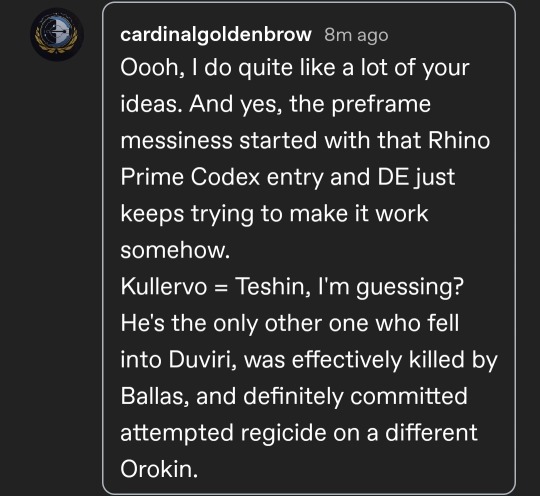
@cardinalgoldenbrow not quite. Something else fell into Duviri.
Not a whole person, but a piece so significant and meaningful that it kicked off the entire paradox meltdown sequence.
The Lotus's hand.
The Lotus had enough conceptual weight to her to give the Drifter the power of the Void, a power the Lotus herself never even had. She is so strongly connected to the Tenno that she connects the Drifter to them by way of her own hand.
Why, then, wouldn't that be conceptually powerful enough to birth a denizen of Duviri?
Gender? Means nothing. Thrax is male and can be spawned from a female Drifter all the same.
Timeline? Duviri experiences time in a way that isn't linear to the Origin System. We already know this thanks to Teshin having been living in Duviri a long time by the time the Lotus's hand lands even though they fell at about the same time.
Let's look at the major beats here.
First, why is Ballas the Warden to Kullervo? "Because he's an Orokin, he's a ruler, the Drifter saw his portraits as a child!" Yeah, plausible, but by that logic Tuvul should be the Warden. Tuvul drove much of the Zariman project. His statues are all over it. The Commons are even named for him. If the Drifter were unconsciously reaching for any authority figure, it should have been Tuvul.
Speaking of authority figures, Executors don't rule Duviri. A king does. Kullervo's texts talk explicitly about Executors and other things about the Origin System in a way that doesn't match Duviri's canon. Why import Ballas as an authority figure and then demote him to Warden all while acknowledging that he ought to be an Executor?
Let's read Kullervo's story.
Hated Kullervo, did you truly believe he could love you?
Oh, huh. Kullervo was in love with an Executor. One of the Seven. That's--rare. Who would love one of those assholes?
Kullervo's criminal trajectory is most strange. He was in love with an Executor, killed an Orokin to prove it, obeyed a direct Orokin order (why does an authority figure call this a crime?), killed someone like a mother to him--an Archimedean he was trying to rescue from Orokin custody, odd detail there--then attacked the Orokin again, then orchestrated the Night of the Naga Drums.
Man's got loyalties like a ping-pong ball, huh? Why?
The children's rhymes tell a rather different story.
An enslaved warrior torn from his mother. He was born to fight, eventually learned a truth of his birth, saw his home lost. He bursts into a rage, murders, and then kills himself.
This is much much much more straightforward. You'll notice that the children's rhymes don't mention Origin System concepts like Executors, either. Nothing about love.
Why all the complication?
Two distinct narratives, both tossing in details that beg for more elaboration. Why do this, as a writer? Why spend the voice actors' time like this?
I can only think it was done on purpose.
Two different stories, two different readings on the same person. One from Ballas, one from children.
(Huh. They say Kullervo is a friend to children, don't they?)
The Lotus lived very different lives from the perspectives of Ballas versus her Tenno.
Natah was born to war, a mimic spy with a purpose. She left her family--not by choice--and killed her fellow Sentients as the Lotus; a betrayer. She then orchestrated the Night of the Naga Drums; a betrayer twice over, the mother of a bloodbath.
Ballas sees her as a betrayer, someone who loved him and threw him away.
We see beats of Margulis's story here, too--an Archimedean that was like a mother, killed in a struggle that wouldn't have existed if not for the choice of resistance.
Kullervo isn't literally the Lotus, but I believe that he was conceptually born from her.
His stories contain the major beats of her life, only slightly twisted by perspective. Those details are so specific--in love with an Executor? Betrayed their own kind, and then their 'ruler'? A mother figure (so specific! Why not just have her as his mother?) who was an Archimedean, killed because of resisting the authority that ruled them both?
Kullervo is made up of her pieces, like a collage.
I believe that Ballas's presence and the sudden mention of Executors when that doesn't match the rest of Duviri are supposed to be clues to us that something from the Origin System has leaked in to birth Kullervo, that he is not simply an independent figure that existed in the past. When Teshin and Albrecht rolled into Duviri, they did simply that--they entered Duviri and adopted its ways while they lived there. They didn't come with an entire chapter of a story that isn't from the Duviri Tales.
Another point to Kullervo being born from Duviri is that he is treated like he exists in Duviri. Nobody says that he suddenly appeared like Albrecht or Teshin. Acrithis talks about him as if he's a part of the story. They all know his history. It's only the Warden who relates such a different history.
I think that the name Kullervo probably did exist as some minor character in the original Duviri Tales. The Drifter's subconscious applied this to the tangle of trauma that the Lotus conceptually exists as.
tl;dr Kullervotus
107 notes
·
View notes
Text

Geographical Narratives: Mapping Leon S. Kennedy's Origins
-edit 20:45 GMT+8 2025/02/01-
To those who have sent me negative messages criticizing my use of AI: Well, yes, I use AI tools like ChatGPT Pro, Claude Pro and Perplexity Pro to assist me in analyzing and writing, along with resources like Google, Quora, YouTube, Reddit, extensively playing the games myself, and even drawing from my personal experiences, movies I've watched, and the knowledge I've gained over the years. I studied film production in my college with a focus on screenwriting and directing. I gather information, analyze it, and synthesize ideas to create something meaningful—and I don't see why that's an issue.
If you lack the initial passion, imagination or knowledge about Resident Evil, NOT A SINGLE TOOL—AI or otherwise—will enable you to create substantial content. I create this fanfic primarily to entertain myself and to share it with those who might also find resonance in it. I’m relatively late to the franchise (Oct 2024, yeah I know, what took me so long?), and since I don’t have close friends to discuss the games with, writing fanfic allows me to explore and connect with the world of Resident Evil in my own way. With a full-time job, I also use AI tools to enhance efficiency in my leisure time, so I can focus on the parts I enjoy most—crafting stories and delving into the lore. For me, it’s about enjoying the process and connecting with others who share the same passion. The fact that I leverage modern tools and technology to enhance my writing and analysis is a choice I make, and it doesn't concern you if you choose not to explore or utilize these resources yourself. Instead of focusing on how something is made, perhaps consider the effort and thought behind it. Innovation and creativity mean adapting to new tools and methods. Using AI—or any resource—doesn’t devalue the work; it amplifies what’s possible. And if we don’t see eye to eye, that’s fine. Party's over and the door’s over there if you need it. 🫶🚪
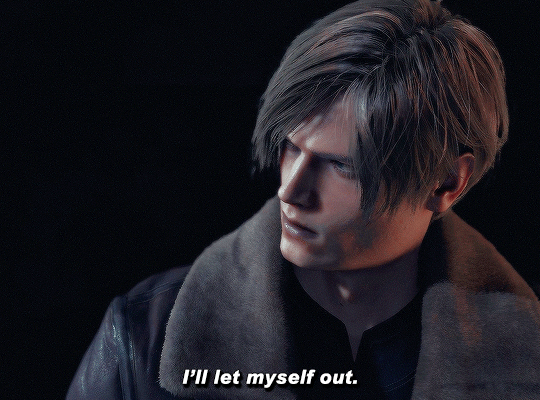
Ok pookies, here we go:
I. Geographical and Cultural Setting
Indianapolis as Leon's Hometown Indianapolis (population 740,000 in 1998) offers a compelling contrast to Raccoon City's metropolitan density (population 1.5 million). With its stable Midwestern character, open layout, and moderate pace, Indianapolis is an ideal environment for the Mitchell family's middle-class lifestyle. Its educational resources and affordable living costs made it a logical place for Leon to grow up in a foster home after the loss of his family.
The distance between Indianapolis and Raccoon City—about 360 miles (580 km)—adds to the narrative. It is far enough to signify a fresh start for a 21-year-old rookie like Leon, yet close enough to make the move practical. This geographical separation reinforces his desire for career advancement, while subtly highlighting the pull of Raccoon City's opportunities, including the prestigious Raccoon Police Department (RPD) and its elite S.T.A.R.S. unit.
Raccoon City's Population Paradox: Why 100,000 Doesn't Add Up With a population of 1.5 million, Raccoon City stands as a major regional metropolis—smaller than Chicago (2.8 million) but significantly larger than Indianapolis. This population size positions it as a city significant enough to be deeply entwined with the operations of the Umbrella Corporation.
Setting aside the official game canon, which states that Raccoon City had a population of 100,000, but why did I estimate it to be around 1.5 million? Let’s start with its ultimate fate—being wiped out by a nuclear strike.
For the government to justify deploying nuclear weapons, Raccoon City would need to have a population of at least one million. This threshold aligns with military decision-making logic, as the use of such extreme measures typically requires a significant threat level, both in terms of the scale of the outbreak and its potential to spread. A city with a smaller population might not warrant such drastic action, as conventional containment methods would likely be considered sufficient. However, if Raccoon City were home to a million or more people, the risk of the virus spreading beyond the city limits would be much higher, making a nuclear strike a more viable last resort to prevent a global catastrophe.
To determine a reasonable population estimate, we can look at comparable real-world cities that fit Raccoon City’s urban and geographic profile.
Bridging the Gap: A Tale of Two Cities The use of both Chicago and Pittsburgh Metropolitan Area (MSA) as references helps resolve the tension between:
Chicago for the canon requirement of location: Midwest city
Pittsburgh MSA for the actual game portrayal in the natural landscape: mountainous (Arklay) and the hills in the city
Pittsburgh MSA for the assumed population
Both cities for the Neo-Classical heritage of architectures
Both cities for the urban development scale
Though classified as a Midwestern city, Raccoon City's geography and economic characteristics diverge significantly from regional norms. Unlike the flat plains typical of the Midwest, the city is nestled within the dramatic Arklay Mountains, whose elevation changes and natural isolation evoke Pittsburgh's position within the Appalachian foothills. This unique setting provides the city with a scale akin to Chicago (the Midwest’s largest metropolis), while its geography amplifies a sense of both grandeur and seclusion. The Arklay Mountains, combined with frequent overcast skies, winter fog, and regular rainfall, create an atmosphere of foreboding—a natural curtain for Umbrella’s clandestine operations. This ominous tone, blending isolation with unease, tragically mirrors the fate that would ultimately befall the city.
II. Urban Development and Visual Identity
Architectural Heritage and Evolution Raccoon City’s iconic police department building, converted from a museum, reflects the rich architectural heritage of both Pittsburgh and Chicago, cities that flourished during the late 19th-century industrial boom. Both cities are known for their grand civic and cultural buildings in the Neo-Classical and Beaux-Arts styles—impressive stone structures with ornate facades, symmetrical designs, and elaborate interior layouts. Pittsburgh’s historic architecture emphasizes heavy stonework and Romanesque Revival influences, while Chicago, though also home to many classical structures, became a pioneer in steel-frame skyscrapers and modern urban development.
Raccoon City’s architectural identity appears to be a fusion of these influences, combining the monumental grandeur of Pittsburgh’s historic buildings with Chicago’s urban scale and development patterns.
Modern Development and Infrastructure The Bright Raccoon 21st Century Plan transformed what was once a "sleepy country city" into a thriving metropolis of over a million residents. This is particularly evident in the remakes of Resident Evil 2 & 3, where the city demonstrates comprehensive urban infrastructure:
An extensive subway system with multiple lines connecting diverse districts
Modern commercial districts featuring impressive high-rises
The grand-scale police headquarters housing elite units like S.T.A.R.S.
Advanced medical facilities including multiple major hospitals
Various entertainment venues including shopping centers and sports facilities
Sophisticated underground networks originally built for municipal services
Urban Zones and Districts This rapid expansion created distinct urban zones:
A modern downtown core dominated by Umbrella's corporate presence
Historic districts preserving the city's industrial heritage
Diverse residential areas reflecting growing social stratification
Extensive suburban developments reaching toward the Arklay Mountains
Research and development districts housing Umbrella's facilities
III. Visual Representation and Media Adaptations
Film Adaptations and Metropolitan Character The city's metropolitan character is most prominently captured in film adaptations, particularly Resident Evil: Apocalypse, which utilized Toronto's urban landscape. The choice of Toronto as a filming location provided the perfect backdrop with its:
Impressive skyline reflecting modern urbanization
Dense commercial districts showing economic vitality
Sophisticated infrastructure networks
Mix of historical and contemporary architecture
The subsequent shift in visual representation seen in more recent adaptations, such as Welcome to Raccoon City (2021) filmed in Sudbury, presents a notably different scale that contrasts with this established metropolitan image. However, the grand urban scale established through the main game series and earlier adaptations remains the dominant image in collective fan consciousness, better supporting the city's role as a major hub of Umbrella Corporation's operations.
Underground Infrastructure Network The city's elaborate subterranean networks serve multiple purposes:
Original municipal service tunnels from the industrial era
Modern subway system connecting major districts
Repurposed sections serving as Umbrella's hidden facilities
Complex drainage systems utilizing the natural river convergence
Emergency infrastructure incorporated into older networks
IV. Population Impact and Catastrophic Scale
Metropolitan Dynamics Raccoon City's population created perfect conditions for both Umbrella's control and the eventual catastrophe. This scale was large enough to justify extensive viral research facilities and enable rapid infection spread through dense urban areas, yet small enough for Umbrella to maintain significant influence over local politics, economy, and public safety.
Scale of Infection and Difficulty of Containment The destruction of Raccoon City with a nuclear strike seems somewhat less justified given its official lore population of only 100,000, as the government might have had alternative methods to contain the outbreak, such as:
Bioweapon neutralization – Deploying gas or specialized vaccines to eliminate infected individuals without obliterating the entire city.
Precision airstrikes and ground force operations – Sending special forces (e.g., U.S.S. or military task forces) to conduct targeted strikes and systematic eradication.
Stricter military quarantine – Completely sealing off the city, allowing the virus and infected individuals to die out or minimizing the risk of external spread.
However, the government ultimately chose nuclear destruction, likely due to several factors:
The severity of the virus – The T-virus is extremely difficult to eradicate. Even a single infected crow or rat escaping could lead to a nationwide outbreak. Thus, even for a city with only 100,000 residents, the government could not afford to take any chances.
Time constraints – The military and federal authorities may have believed that containment efforts would be too slow compared to the rate of viral spread, making a swift and decisive solution necessary.
Political motives – Umbrella Corporation had deep ties within the government and may have influenced this decision to cover up its involvement.
Comparison 100,000 Population (Official Setting):
A city of this scale is relatively small, making quarantine measures easier to enforce.
If the military intervenes swiftly, targeted airstrikes and bioweapons could potentially contain the outbreak without resorting to nuclear weapons.
However, considering the virus's incubation period and its potential transmission through animal carriers, the risk remains high, and the government might still opt for extreme measures.
1.5 Million Population:
This is now a large metropolitan area, making containment significantly more difficult.
If 1.5 million people descend into panic and chaos, the government would struggle to maintain order, as societal collapse would happen rapidly.
A larger number of infected individuals increases the likelihood of military quarantine failure, drastically raising the risk of viral spread.
This makes nuclear strikes a more "rational" choice, as traditional methods (quarantine, airstrikes, bioweapons) may no longer guarantee complete eradication of the virus.
Disaster Implications The city's population density proved crucial in several aspects:
Infrastructure Impact: Dense population networks facilitated rapid viral transmission
Crisis Management: Urban density accelerated infection rates beyond containment capacity
Evacuation Complexity: The sheer number of residents overwhelmed evacuation procedures
Federal Response: The risk of 1.5 million potential infected spreading beyond city limits justified the extreme measure of nuclear sterilization
Scale of Catastrophe The population size of 1.5 million directly influenced the disaster's progression:
Rapid viral spread through densely populated areas
Overwhelmed emergency services and healthcare facilities
Failed evacuation attempts due to massive population movement
Justified federal government's extreme containment measures
Created a crisis too large for local control but contained enough for complete sanitization
How well-known was the Raccoon City incident internationally? According to official lore, the Raccoon City incident was partially exposed to the world, but much of the truth was concealed.
In Resident Evil 4 & 4R, when the U.S. president’s daughter, Ashley, is kidnapped, Leon is introduced as a survivor of the Raccoon City incident, indicating that high-ranking government officials were aware of the event.
In Resident Evil 5, the formation of the BSAA (Bioterrorism Security Assessment Alliance) suggests that the tragedy of Raccoon City became a catalyst for global action, meaning at least some nations knew about its severity.
In Resident Evil 6, bioterrorism had become a worldwide crisis, implying that the Raccoon City incident was the starting point. However, both the government and Umbrella likely hid key details from the public, preventing it from becoming fully known as a global catastrophe.
V. Umbrella Corporation's Strategic Operations
Control and Corporate Influence Raccoon City's size proved perfect for Umbrella's operations:
Large enough to justify extensive research facilities and corporate presence
Small enough to maintain significant political influence
Complex enough to hide suspicious activities
Isolated enough to contain potential incidents
Developed enough to support advanced research facilities
Historical Context and Operations In 1968, the same year Umbrella was founded, Leon's father joined the company's logistics brach as a mid-level manager in Indianapolis. By 1985, his discovery of suspicious shipping patterns led to the tragic elimination of Leon's family, demonstrating Umbrella's ability to quietly remove threats while maintaining its legitimate facade.
Strategic Geographical Separation The calculated distance between Umbrella's research facilities in Raccoon City and its distribution center in Indianapolis represented more than a mere logistical decision—it was a deliberate corporate strategy of calculated compartmentalization. By establishing physical and operational distance between its most sensitive functions, Umbrella created a sophisticated buffer against potential external scrutiny.
Indianapolis offered an ideal distribution hub: centrally located, with robust transportation infrastructure that allowed seamless nationwide pharmaceutical product movement. Meanwhile, Raccoon City's isolated topography provided the perfect environment for confidential research, shielded by complex geographical features and an urban landscape marked by industrial decline and bureaucratic opacity.
This geographical strategy served multiple purposes: it dispersed corporate risk, complicated potential investigative trails, and maintained the appearance of a conventional pharmaceutical enterprise. Mid-level managers like Leon's father, positioned within these carefully constructed operational networks, remained vulnerable yet critically positioned—close enough to observe irregularities, yet expendable enough to be silenced without widespread alarm.
The separation was not just about efficiency, but survival—both of the corporation's interests and its most dangerous secrets.
Threat Neutralization Protocol The choice of middle management in logistics rather than pharmaceutical executives as targets reveals Umbrella's calculated approach. Unlike high-profile executives who mainly dealt with paperwork, mid-level logistics managers had direct access to physical evidence of suspicious activities. Their position made them more likely to notice irregularities while being easier to "handle" without drawing attention. Their relatively lower profile in the corporate hierarchy meant their sudden "unfortunate accidents" would raise fewer questions than the death of a senior executive.
Economic and Social Contrasts The economic and social dynamics between these cities in the 1980s-90s prove revealing. Indianapolis, with its stable social order and emerging status as a logistics hub, served perfectly for Umbrella's legitimate operations. Its straightforward crime patterns, community oversight, and robust public security made it ideal for maintaining a clean corporate image. Meanwhile, Raccoon City struggled with industrial decline: unemployment, deteriorating infrastructure, organized crime, and corruption. These conditions, combined with its isolated geography and complex underground infrastructure, made it perfect for Umbrella's questionable research activities.
VI. Impact on Leon's Character Development
Career Choice Context The contrast between Indianapolis and Raccoon City shaped Leon's career aspirations. This is particularly evident in the Resident Evil 2 Remake, where his reference to Raccoon City as a "big city" reveals much about his background:
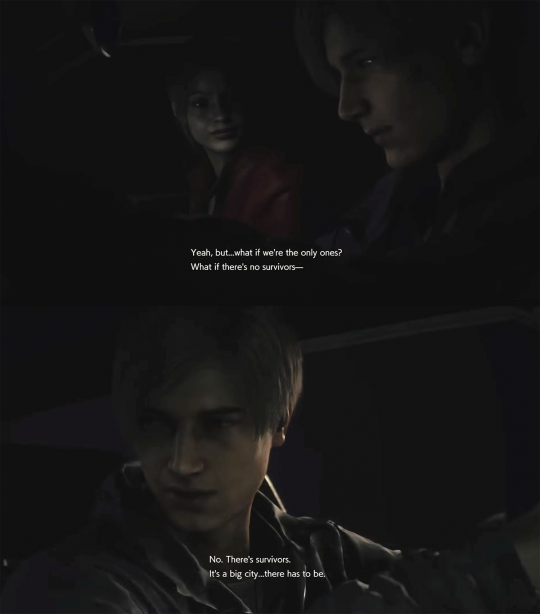
This perception is particularly evident in a key moment from Resident Evil 2 Remake, where Leon tells Claire "It's a big city...there has to be [survivors]." This seemingly simple line reveals much about his background and character.
Why? Allow me to shed more light on this 👇 Moving from Indianapolis to Raccoon City reflects:
The genuine awe of someone stepping into a larger metropolitan area
The optimism of a rookie officer facing his first major assignment
The appeal of joining a more prestigious police department
His untested perspective is shaped by:
Moving from a modest Midwestern city to a major urban center
The allure of RPD's specialized units like S.T.A.R.S.
The promise of career advancement and new opportunities
Psychological Journey As a 21-year-old rookie, Leon embodied a mix of optimism and naivety. His outsider perspective made him uniquely observant of the city's contrasts—its modern developments overshadowed by systemic corruption, its bustling streets tinged with unease, and its apparent prosperity marred by corporate control. His first day would transform this optimistic rookie into a hardened survivor, marking the beginning of his relentless quest for truth and justice.
VII. Conclusion
The contrasting dynamics between Indianapolis and Raccoon City form a rich backdrop for Leon's journey. The geographical and social differences between these cities not only shape his character development but also underscore the broader themes of ambition, resilience, and the devastating consequences of unchecked power. The tragic irony of Leon unknowingly walking into the same darkness that had changed his life thirteen years earlier adds a profound layer to his story of personal growth and determination.
The scale and complexity of Raccoon City, with its population of 1.5 million, proved to be the perfect setting for both Umbrella's machinations and Leon's transformation from an optimistic rookie to a hardened survivor. This carefully constructed urban environment, with its blend of historic architecture and modern development, its extensive infrastructure networks, and its hidden facilities, created an ideal stage for the tragic events that would unfold during that fateful September of 1998.
--------
Note: This analysis combines canonical information with real-world contexts to create a coherent background setting for my ongoing Resident Evil fanfiction "The Berthing". By examining the real-world geography and socioeconomic conditions of Indianapolis and Pittsburgh in the late 1960s-90s, I aim to construct a plausible foundation for Leon's journey from his childhood tragedy to his fateful assignment in Raccoon City. This research particularly supports the Mitchell family arc in my story, where Leon grows up in a middle-class Indianapolis foster home before his eventual move to Raccoon City. As a non-American citizen and only been a traveler so far, I've researched these locations and their cultural aspects carefully, but I welcome insights and discussions from readers familiar with these places. Your perspective would be valuable in enhancing the story's authenticity. Lastly, I'd apologize for any grammar or typo mistakes since English is not my native language!
#resident evil#leon kennedy#chreon#chris x leon#fanfiction#fanfic#ao3#leon s kennedy#geography#culture#raccoon city#amwriting
23 notes
·
View notes
Text
How is it that I have read these books so many times and only now do I recognize the narrative parallel of Sam having a conversation with himself while Frodo sleeps, in which he argues down the "internal voice" urging him to give up and saying it's all useless, just as he overheard Gollum having a conversation with himself a couple of weeks before? And this after they've cast off everything but what they can't possibly leave behind - after Sam leaves behind that last bit of domesticity he has let himself keep carrying in the form of his pans - slowly shedding all those trappings of "civilization" that keep them distinct from Gollum?
I feel like there might also be some symbolism here in that Gollum has so often been associated with water - fish and slime and dark damp caves - and Sam is depriving himself of water on this dry, fiery road to the Ring's destruction. He's giving it all to Frodo - and denying to himself - the vitality that maybe Gollum leaned into in some kind of subconscious attempt to replace the vitality that the Ring was sucking away from him? Frodo is being stripped of his very self, and Sam is not far behind, stripping away all the things that make him what he is.
I also don't think I noticed that Sam is also carrying Frodo's phial for him here. I was going to say that it must be significant that the two things they keep with him are the things that will symbolize their ultimate healing (Frodo the light beyond the world; Sam the soil that roots him to this one), but the fact that Sam is also carrying that light for Frodo is even more tender and meaningful, somehow. Maybe the light would hurt Frodo at this point, the way that the elves' gifts hurt Gollum, but Sam is holding onto it for him because he believes that that light will return to Frodo. Frodo can't see anything for himself, any light beyond that wheel of fire, but Sam is holding onto it for him, holding his - well, not humanity, but you know - and Sam is himself the roots that will keep Frodo going for as long as he does. It can't be forever, maybe, but - just like his resistance to the Ring - it will be just for long enough.
Wow I love these books so much.
#lotr newsletter#frodo#samwise gamgee#gollum#frodo x sam#so sorry for this patchwork analysis haha i'm sure this is very rudimentary really#but it's stuff i noticed for the first time
87 notes
·
View notes
Note
Semi related to the "Mayomoff" thing, but I really dislike sometimes how cb twt tries to distance Billy from Wanda. I get it's a way to overcompensate because MCU stans usually have the misconception that Billy and Tommy were raised by Wanda, but the insistence feels icky. By the way these people write about these characters, it would make you believe that Wanda tried to steal baby Billy from Rebecca's arms (anti roma tropes are still super present even in "leftie" fandom spaces).
This has been a thing for years, and I've definitely noticed an uptick recently, from both sides, in response to Billy's imminent arrival in the M C U. I think a lot of comic fans, in particular, have a hard time accepting that characters can be more than one thing, or have more than one important storyline or relationship. Whether or not you find it interesting, Billy's relationship with Wanda is a major part of his story, and both characters care about each other a great deal. If you think you can have one without the other, you've lost the plot.
But if I'm being honest, I do think that racism is a part of the problem. People undervalue Wanda's relationship with her sons because they don't understand the significance and nuances of Romani heritage and identity. They undervalue how meaningful a story about family separation and reunion can be, because they have no investment in our history or generational trauma. I think a lot of folks are not willing to hold the space for those perspectives or learn from Roma voices. When we talk about representation and authenticity, a lot people think they need to understand the interiority of Romani culture, but I think these experiences and historical perspectives are much more important.
On top of that, a lot of people seem to think that acknowledging Wanda as Billy's mother or labeling him as a person of Roma heritage somehow erases other aspects of his identity. In some cases, this is well-intentioned-- Jewish identity can be just as nuanced and specific, and needs to be respected-- but a lot people clearly just feel threatened by the idea that he might not be white. And that's a real shame, because in my mind, Billy's Romani heritage only adds to the richness of the character. Mixed families with varied identities exist, and there several real-world experiences you can map Billy's identity onto without invalidating his Jewishness.
-----
Homophobia and gender anxiety are also important factors. I've been following this character for nearly two decades, and I find that Billy's depiction, and how fans respond to him, often reflect shifting attitudes about "positive" gay representation-- specifically, where femininity, diverse gender expression, and gay cultural semiotics fit into that narrative. [x] [x] The character has always been legible as a certain type of gay guy, and over the years, more writers and artists have taken license to explore that aspect of Billy's style and personality. All told, it's pretty subtle, and since most of those writers are gay/bi men, I usually find it quite authentic, but certain fans-- particularly the Young Avengers fanbase-- always respond negatively to any degree of femininity or androgyny.
Billy's proximity to Wanda-- as a legacy character based on a female hero, and as a man who identifies positively as a "witch," when that word is used with explicitly feminine connotations elsewhere in the Marvel canon-- evokes a lot of those same responses. Again, I think this is a perfectly authentic and frankly very common relationship for gay men to have with femininity. But characters like that are rarely represented as powerful, admirable, or desirable, and Billy is all of those things. To me, that is positive representation, and anyone who can't see that has an internalized bias they need to work on.
On the flip side-- homophobia and transphobia are on the rise in America, and I really think the pendulum has swung back around in terms of how comfortable people are expressing those views in public. I've been more plugged into the M C U fandom lately because of Agatha, and I've seen a lot of folks just saying mean, homophobic things about the actor and character. I don't want to defend Locke, because of the whitewashing, but that sort of hate okay is not okay.
24 notes
·
View notes
Text
so here's the thing...
i've written about this topic a few times during and after season 1, but the carmy and sydney of it all remains a highly contested and discussed topic. even after season two.
what i find so truly fascinating is that chris storer and joanna calo and everyone involved with the creation of this lovely, well constructed show absolutely could have created the duo they work SO hard in the press to convince viewership they intended.
if they really wanted sydney to be a psuedo/standin sibling for the one carmy lost, or the brainy, determined business partner that comes in to orient a sinking ship...
there are a couple hundred ways they could have managed that and made it abundantly clear that's what the angle was within the dynamic between carmy and sydney.
instead... we have all this very overtly (and covertly) romantic, potent and simmering subtext regarding the nature of their relationship and what they mean to one another, their effect on each other and their seemingly endless potential.
in a whole host of ways there are a number of scenes that literally don't make sense without the lens of the undercurrent of feelings or reverence or romance or something that exists between them beyond the intended business partners/co-creatives.
there are ways to narratively parallel sydney as a mirror and equal and peer of carmy's void of all ambiguity and romantic tension and any energy of awkward longing or confusion.
but that's not actually what we got. i've been consuming television media for most of my life. i've watched hundreds of shows; shipping has never been a requirement for my viewership or interest.
which leads me to believe that there's either a bunch of deflection/dismissing happening for a very distinct reason. or there's been a bait and switch planned from the beginning.
you would literally have to remove 75% of the nuance within carmy and sydney's interactions for the stictly platonic claims to make sense and effectively land.
you'd have to go through and remove various staging, shot selection, editing, music choices and sometimes entire scenes to accurately convey original or "intended" messaging.
to completely eradicate the liminal space of subjectivity between them.
why is carmy talking about tina looking like sydney with that distinct expression on his face when they all wear that apron?
why are they being awkward at the lockers like it isn't customary for coworkers and business partners to go out after work for dinner or drinks or whatever (literally evidenced by tina this season)?
why is sydney mentioning jealousy at all when it comes to carmy's relationship? especially when it makes perfect sense for her to be upset with him for not pulling his weight?
why is sydney entering into carmy's life for the first time and deciding to stay, the second time, something that literally brings him out of his panic? when it could have been him cooking, his drawings, his staff, his gf. ANYTHING else.
they effectively made sydney an emotional, mental and energetic tether for him in that scene. for what reason? business partner ones or????
why do they bicker like an old married couple? is that customary for creative collaborators and coworkers?
why superimpose sydney, parallel her doing something the audience saw carmy do last season, and then show her going about her night while he's by contrast, with his girlfriend? why show a random closeup of a meaningful tattoo on her shoulder? no thematic significance beyond the grind of the restaurant world and career ambition?
why is there an obvious awkward breaking of energy after a highly vulnerable and tender moment between the two of them under the table? why does sydney noticeably fidget/adjust herself/her apron when he walks away to get her gift?
there's actually a hundred instances of these questions you could ask over the course of the two seasons when it comes to them.
so the reasoning behind the shipper pushback is baffling and a bit laughable.
some people bring into question, perhaps this is just the natural chemistry that jaw and ayo bring to their characters bc they're obviously good friends.
which... sure. i guess. but even that begs the question, you wrote and shot and constructed a story a specific way and then your two actors sort of bled on and expanded the material in a very obvious way you didn't expect?
cool, cool. so again... you're surprised that could lead to viewership seeing something deeper than mere platonic business partners?
that's shocking and surprising to you?
no way.
especially considering storer and calo have commented on how close jaw and ayo are and that their dynamic is different than the one she has with ebon and lionel. which is hilarious bc she adores ebon and has been out of the country traveling with lionel (and some other people from odd future.)
so clearly they all enjoy each other, are friends and get along.
but why even make that note of demarcation regarding jaw and ayo's dynamic and STILL be like "oh yeah, we didn't write or mean for them to be a romance " you're shocked that people SEE something given your storytelling and their obvious connection that even you, the creators themselves remarked on?!?!
there's a picture from the golden globes of ayo holding jaw's mom's hands during his acceptance speech. like they're really besties.
but i'm sorry, they can't bestie themselves into what carmy and sydney clearly exemplify on our screens without an entire framework at their disposal. because they're talented and professionals.
so if the writing is saying something, then it's intentional.
maybe the intention was to have their characters skirt and skate on the periphery of each other.
maybe it was for things to be awkward and weird and undefined or hectic and toxic.
maybe they weren't ever gonna have some relegated idea of a shipper's happily ever after.
people have feelings that go unexpressed and undefined. people fall in love and then don't end up together.
maybe the slow burn fizzles out, maybe it explodes or implodes, maybe one of them self denies, maybe they both do.
maybe it will or won’t be addressed directly or covertly. that's actually not a requirement for its existence.
to act like there isn't something true and obvious and visceral that exists between these characters is frankly like asking those who watch your show not to use their eyes and their brains.
impossible.
#sydcarmy#the bear fx#carmy x sydney#carmy berzatto#sydney adamu#let's act like we can all consume media and hold various elements and arcs and constructs within our minds
214 notes
·
View notes
Text
Background paintings in Ikevamp and why they matter

...even if you are not familiar with art.
Warnings: minor spoilers for all routes, though I tried to keep it as vague as possible
Time to talk about background paintings in Ikemen vampire because…why not?
First, let me warn you that the following is nothing but a theory based on some visual resemblance. While it may occur that Ikemen designers wanted to hide a few Easter eggs, it's also fair to mention that sometimes the sky is blue just because it's Sunday morning, and that’s all.
Nevertheless, one detail may hint at the former statement being true. And this is because there’s a significant difference in how different paintings are shown in the game.
Some of them are blurry, overdark or too bright. While we can distinguish some unclear silhouettes, the rest is on our imagination.


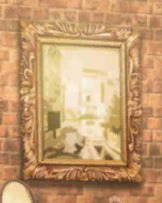
For example, it seems that the first picture is the natural landscape (probably, sunset in the forest) as well as the second one with the Ionic style columns being placed in the center of a garden. Still, we’re not sure.
But the thing is it doesn’t matter. The amount of details the viewer is given is too small for us to make any art-historical assumptions. Based on these mere images we can figure out neither the artist who painted them nor the narrative. Therefore, these paintings have only a secondary function of background decorations and proof of demonstration of their owner’s wealth.
On the contrary, there are paintings that we can easily detach because their creators are too famous to be unfamiliar with. But even within this scope of paintings there is a slight differentiation due to the way they are incorporated in the game design.
Some of them have been revived by the hands of geniuses who once created them. This is the case of Leonardo’s Study of a woman’s head and Study of Hands


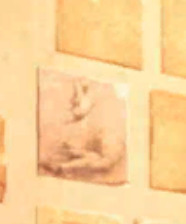

or Vincent’s Sunflower and the Olive trees


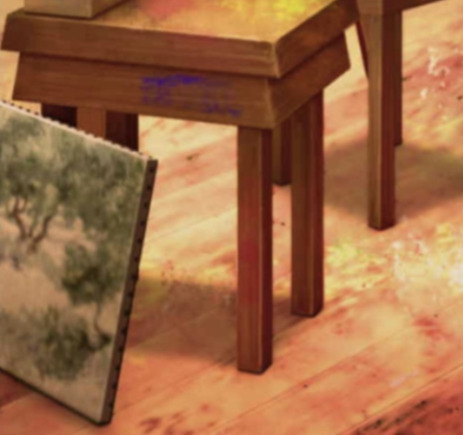
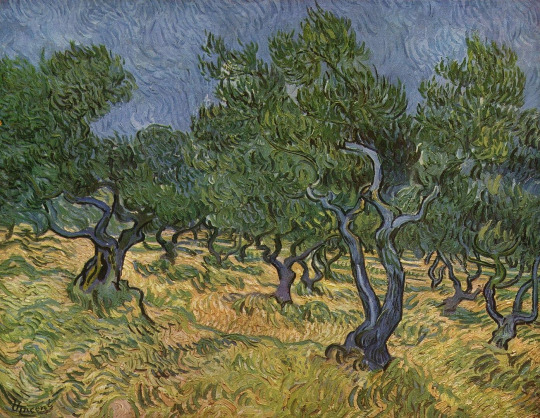
While it’s easy to reduce the meaning behind this design decision to simple hype, I think that it also serves as a visual representation of the suitors' character traits. What is the point of redrawing the painting that was already brought to life a long time ago? For Vincent it means years, for Leonardo - centuries. My guess is that for artists like them it's never enough. Life is too beautiful to be captured once and forever. A woman’s face is never a mystery solved. While for many people it’s okay to achieve a goal and forget about it the exact minute they are done, for geniuses like Leonardo and Vincent it’s always different. You must improve. You have to work further. There is always something new an artist’s eye can capture. That’s why they painted it again, again and again.
Let's move to another group of paintings. Spotting The Starry Night in Theo’s room is not a surprise because we know that, first of all, they’re brothers with Vincent, and, secondly, Theo is an art dealer.

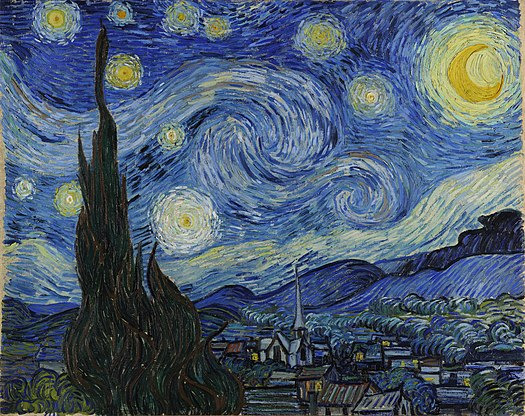
What deserves to be brought into focus is that this work is regarded as the elder Van Gogh’s magnum opus. Sure, you can argue that the real Theo and Vincent thought little of this painting, calling it “a failure”. To which I reply that, again, this is a game for numerous people across the world, including those who are not familiar with art history. For many of us The Starry Night is viewed as one of the most popular art works, a special work, a valuable one. Therefore, by omitting historical accuracy Ikemen writers and designers try to achieve something more contributing to the plot - they try to evoke certain emotions. Putting the art of such great significance in the room of one of the brothers should be a clear indicator of the amount of respect and love the two of them share. Describing the emotional bond between them is mainly the prerogative of writers. But sometimes game design plays no less if not more meaningful role in the process of us as readers getting familiar with characters. The painting here becomes a subtle part of the plot as it highlights certain prerequisites of their relationship and prepares us for what is going to come next.
The latter is especially relevant to Vlad's route. The female portrait in the pureblood’s room is what takes background paintings in Ikevamp on a fundamentally new level - the level of plot-forming core.

Unlike those paintings I mentioned at the beginning, these ones are no longer a substitute for the room decor. Instead, they serve as a device that pushes the plot forward. It accumulates three major points that are relevant to the plot:
It adds the mystery element for triggering our curiosity. The portrait is ‘faceless’, and even though we all see the resemblance in features, there is this ‘if’ element. What if they decided to go with a classical Dracula plot? Eternal vampire loses his lover and waits for her to be reborn? Is this MC? Why can’t he remember her face?
The portrait itself allows us to get for a second into Vlad’s head and understand his feelings towards the mysterious woman. Vlad drawing her portrait is caused by the act of kindness she showed him. His entire motivation is connected to the single painting. She was the one who he wanted to be with. In order to do so, he had to become strong, to accept his tragic loss and move forward. The portrait serves as a silent reminder about what was his goal and why he chose the path he chose.
It circulates the narrative. At the beginning, MC faces the challenge of being the third one in the relationship with Vlad and his unknown lover. She questions the identity of that unknown counterpart of hers and secretly wants to learn more about her. By revealing the truth of Vlad’s past and their connection, MC figures out who was the woman in the painting which in some way pushes her to find enough strength for making a certain groundbreaking decision.
Finally, there is the third group of paintings that possess what I call ‘potential meaning’. These paintings maintain the main features of the two previous groups, namely, vague silhouettes combined with a rather clear narrative that somehow increases the possibility of them being more than a decorative object.
Take a look at the two paintings in Vincent’s room. In comparison to all other paintings these ones differ not only in terms of shape but also in terms of color. The lines seem to be more fluid, and the color palette is dominated by ochreous, blue and black which is typical for East Asian classical ink art. By taking a closer look, you can actually see the vague outlines of the sea and shrouded in mist mountains in the background. Personally to me such landscapes together with a specific composition angle remind of Hokusai’s Thirty-six Views of Mount Fuji which can be a great allusion to Van Gogh’s obsession with Japanese prints and their role in his artistic career.



The huge painting in Comte’s living room has been haunting me for years, I shall admit. It portrays a marine landscape with a single boat chasing the wild waters in the dark or right before the sunrise. When talking about marine art, the first person that comes to my mind is Ivan Aivazovsky. Yet, it is evident that Aivazovsky’s style was pure romanticism with heavy realistic elements, whereas this painting looks like it's more about light and colores rather than clear and precise lines. And also this sun, this strange orange sun..that can be spotted only in Claude Monet's Impression. Sunrise.
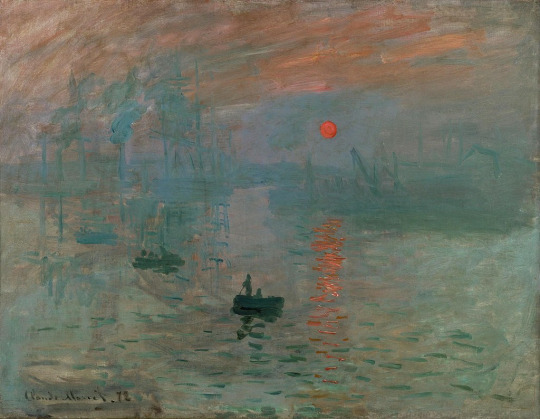
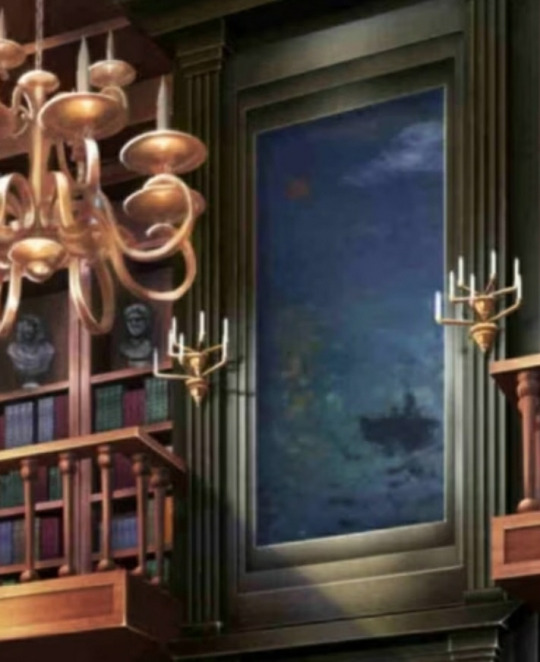
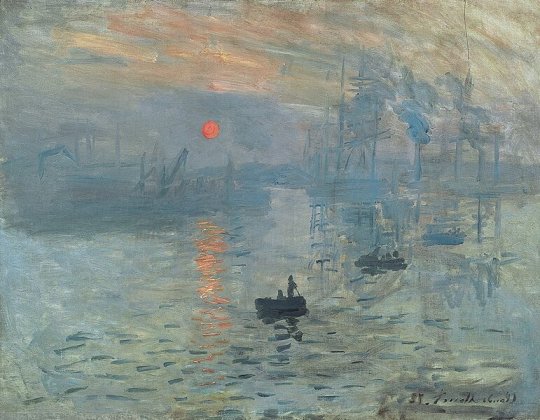
The mansion’s copy is a darker mirrow image of the original work. Nobody knows why Comte chose this painting for the mansion, but isn’t it a bit of irony that the painting that praises France, the country that suffered from the war with Prussia and was on its way to revitalisation, is located in the house that is about to face the battle between the lesser vampires and their haunters or rather the figurative war of two different morals (we are yet to know about it, though)?
Another version is that the painting serves as a metaphoric description of the character. In various routes MC mentions how Comte reminds her of the sun that made manifest, and everything supports this claim to be true, from his golden eyes and hair, to the brightness of the room and..paintings that symbolize the master of the mansion.
Finally, I wouldn't forget about the massive backlash Impressionists had to face at the early stage of the movement’s existence. It was only until the 5th Impressionist exhibition in 1880 that the artists finally got praised by critics. Just a bit more than 10 years before the MC’s appearance. However, we know that the creation of the mansion had taken place before this event. So, my point is that probably Monet’s painting was purchased by the greater vampire during the times when Impressionists were still harshly criticized by the Salon. And if so, the display of the painting that represents the les misérables of the art world speaks so much volume about Comte’s character and devotion to fulfill what he perceives as his noblesse oblige - to support those in need, to help them reveal their talent no matter what social class they belong to.
The game room’s central painting is another amusing detail as it’s completely out of mood. Playing cards, watching chess games or taking any other light leisure activity with a glass of brandy in your hand, you rarely expect to raze your gaze from the table only to stare at the image of ruins. Yet, this is what we get here - a typical capriccio painting like those of Alessandro Salucci and Leonardo Coccorante.


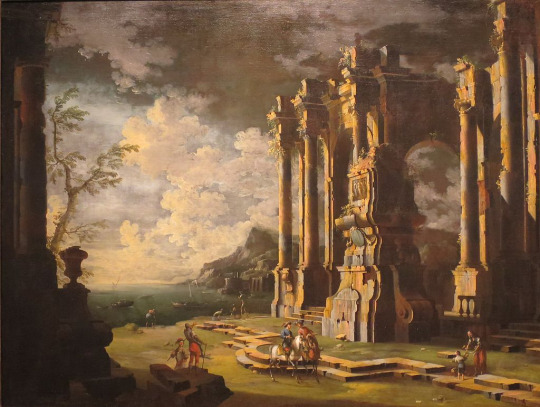
Capriccio artists dared to do something new in the history of art - they put real archeological signs into fantasy surroundings, sometimes from the same time period that the artists lived in. To an extent, they brought the ancient past and allowed it to live in the future, which is not a bad allusion to the original purpose of the mansion’s creation.
And here is what we can spot in Shakespeare’s room. At first, I didn't think much about this painting in Will’s bedroom but something felt odd. And then I understood.
You see, there’s this famous Vincent’s work named Cafe Terrace at Night. The painting is created from the north eastern corner that allows us to see the starry night without facing an obstacle in the form of the cafe's roof.
But this is how the modern cafe looks from a different perspective. Yellow elongated building with two wide niches that serve both as windows and entrance.


Do you see it, right? RIGHT?
I headcanon that Vincent was so eager to spoil his new friend with a present that he decided to redraw his favorite work and give it to the bard. But being an empathetic and observant one, Vincent immediately figured out Will’s admiration of everything unique and rare, so he decided to create a completely new version of his own painting instead of just redrawing it from the same angle as he did with sunflowers.
Aaand this is what we get in the living room. Random at first sight, the composition of various unrelated pictures actually makes sense. The most evident one is, of course, the image of theater curtains. What else should we expect to see in the manor of the great Bard of Avon? The same curtains, by the way, appear in almost every scene where MC and her suitor are invited to Shakespeare’s play.

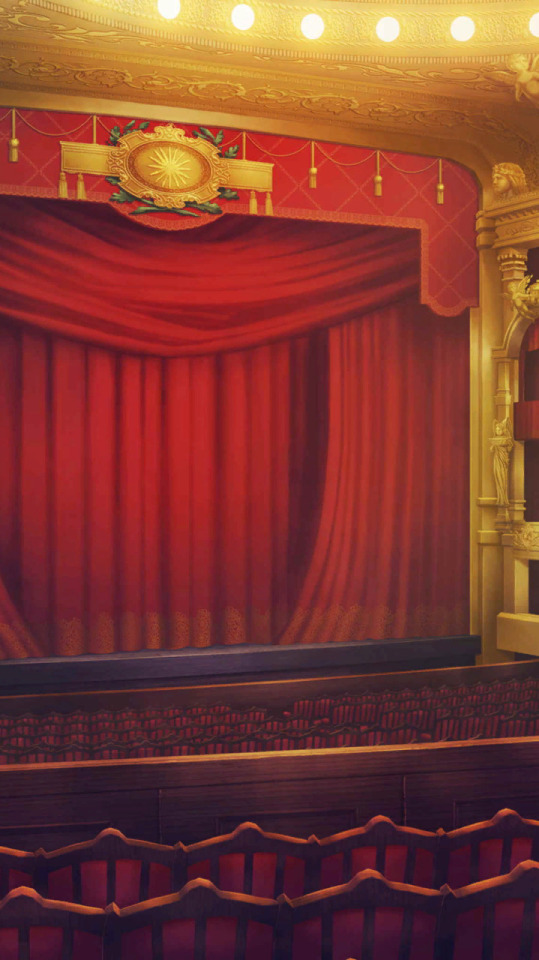
Just a small detail, but I think this is one of those rare occasions when we can actually name the place Ikemen writers took inspiration from (apart from, of course, Louvre and the University of Paris). What helps us here is the curtains over which we spot golden metal lambrequin with a cartouche that imitates the image of the sun.

Such a prolonged lambrequin with the sun image (in honor of Louis XIV, the Sun King and also the father of the Paris Opera) in the center actually exists only in one Parisian theater - Opera Garnier, where in 1888 Shakespeare’s Roméo et Juliette was staged.

Just to make sure, look at the curtains in some of the most popular theaters that existed during the historical period in Ikevamp - Théâtre du Châtelet or the Opéra-Comique. You won't find a similar one.
Two last possible Easter eggs may be related to the two historical objects that existed during Shakespear’s era. The first one is still connected to the curtains for as you see, there were rumors (modern archeological findings prove them to be true) that the first venue of Shakespeare’s plays was called ‘the Curtain Theatre’.
And the second thing I want to point at is two images of the chair. Honestly, I highly doubt that a person like Will who has an almost narcissistic obsession with expensive staff would put a painting of such low value in his private apartment. But I can understand it, if this is not an image of some random piece of furniture but the well-known Shakespeare’s Courting Chair, wherein, according to William Henry, ‘the bard was used to sit, during his courtship, with his Anne upon his knee’.
Anyway, I hope it wasn't too much. Thank you for reading!
#ikemen vampire#ikevamp#cybird#ikemen series#ikevamp shakespeare#ikevamp vincent#ikevamp comte#ikevamp vlad#ikevamp theo#ikevamp leonardo#ikemen le comte#ikemen leonardo#ikemen theo#ikemen vincent#ikemen shakespeare#ikemen vlad
306 notes
·
View notes
Text
Script Doctoring(?) Doctor Who Season 1
Here’s how I would fix the thematic and mystery box issues of this season of Doctor Who while keeping almost everything else the same.
This season would refocus on the thematic tension between Ruby with her desire to find her birth mother and the Doctor’s avoidance of finding Susan. By adding a few choice moments in the Tardis at the beginning and end of certain episodes where Ruby tries to convince the Doctor that finding Susan is important, you would add some really nice character development and even tension to Ruby and the Doctor’s relationship and get to more explicitly explore and discuss some of the big thematic ideas that this season ostensibly centered around like family and fear of abandonment /rejection.
I also think that having the god of death in this season doesn’t make much sense in terms of the themes, so I would probably swap out Sutekh for the Trickster as many others suggested. With the Trickster, you could have the narrative-manipulating, story-changing surrounding Ruby make a lot more sense in universe. This could then better match with the idea that Russell already had: that we imbue things with importance and can thus rewrite our own narratives. Imagine Ruby as central to the finale because her desire to rewrite the false narrative in a positive way could directly counter the negative attempts to rewrite the narrative by the Trickster. Thus, she’s still just an ordinary person as RTD intended, but she is learning to overcome her fear of rejection and abandonment by fixing the negative story that both her own mind and the Trickster have written about her life as she knows she is worthy of love, there’s nothing inherently wrong with her, etc. (A great opportunity to make Carla‘s inclusion narratively significant, too, as she actively contributes to this!)
This would also make the moment where the Doctor cautions Ruby against reconnecting with her birth mother a more meaningful emotional payoff, because Ruby isn’t afraid to try reconnecting with her mother and it goes so well despite the Doctor’s own fears. This could serve as a turning point for the Doctor as he realizes that getting over your fear of rejection can lead you to new avenues for happiness and connection.
Then, instead of having a sorrowful “the doctor is always alone” ending to the season, have the last line of this season be the music swelling triumphantly and the doctor declaring that, yes, he’s going to go find Susan. This would show the actual impact that Ruby had on him and allow his character to go through some growth rather than end up where they’ve always been. (Plus, what a fun teaser to leave the audience on haha.)
You could then spend the second season, (which was ordered at the same time as season 1) on the Doctor trying to track down any clues of where Susan is. So, the season-long arc would become the doctor looking for Susan, but getting sidetracked in the typical adventure of the week.
NOW you can justify Sutekh as the big bad for this second season. If the doctor is actively looking for Susan, it makes a lot more sense that Sutekh would use her to lure the Doctor in and more devastating when it’s revealed Susan Triad isn’t her. Thematically, this works because the Doctor claims to have never reconnected with Susan before because they were terrified that they would either hurt Susan or she would already be dead, so the big bad being death this time around would haunt him: The Doctor is too late and it’s all his fault.
In terms of the “I am life, and you are death” theme, this also makes a lot more sense within a context of actively trying to find Susan, because the doctor is so afraid that he brings death, but the fact that Susan exists at all (and perhaps he finds her or some evidence of her life) in addition to the amazing family he’s built across time and space rallying around him (like Ruby, Mel, Kate, and Rose which justifies a unit based episode AND the memory Tardis as the Doctor’s equivalent of Carla’s wall of photos of her foster kids) is proof that he isn’t a “harbinger of death.” That all of us defeat death when we choose love and support for ourselves and offer it to others. Self indulgently, I would love a conversation between the Doctor and Cherry about family and found family, too. Imagine how wonderfully thematic it would be if this ordinary woman gave the doctor what he needed physically and spiritually to save the day: grandmother to grandfather. Heck, maybe she is the one who gives him the spoon. A teaspoon in fact :).
So anyway, those are the big changes that I think you could make and leave literally everything else the same to get a better emotional payoff and prevent the audience from feeling a little robbed by the mystery boxes.
#doctor who#dw spoilers#season rewrite#empire of death#Also#self indulgently it gels really nicely with the timeless child arc idea that the doctor literally brings life as the source of regeneration#I know a lot of people dislike that arc But imagine if Susan is somehow killed in the confrontation with death#But because she can regenerate she lives and the doctor defeats death in more than one way#give me Carole Ann Ford lol
24 notes
·
View notes